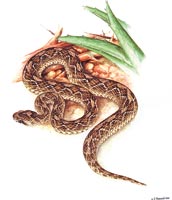The Hump-nosed viper has moved a notch higher, joining the Cobra, Krait, Russell’s viper and Saw-scaled viper as the “deadliest” venomous snakes in Sri Lanka.
Earlier listed as “moderately” venomous, the Hump-nosed viper has acquired this ignominious status of highly venomous after its bite indicated rare but potentially fatal systemic envenoming, said Consultant Physician Dr. Kolitha Sellahewa who is Chairman of the Snake-bite Expert Committee of the Sri Lanka Medical Association.
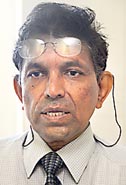 |
| Dr. Sellahewa |
A snake-bite not only leaves in its wake local tissue damage at the site, characterized by pain, swelling, blistering, haemorrhage and necrosis (death of cells or tissue) but also systemic (affecting the whole body) effects such as bleeding (haemorrhage), non-clotting of blood (coagulopathy), neuro-toxicity (neurological problems), respiratory problems and renal failure which are life-threatening, explains Dr. Sellahewa.
Of the 61,000 snake-bites, a majority of which are non-venomous, recorded each year at state hospitals, about 27% of the venomous bites are by the Hump-nosed viper, the Sunday Times understands. The most number of deaths, (97%), are from the bite of the Russell’s viper, Cobra and Krait
Although those days most snake-bites were in the North Central Province, now victims are being reported even in areas in the suburbs of Colombo like Malabe because territory inhabited by these reptiles is being cleared, according to Dr. Sellahewa who has a long history of not only studying but also treating snake-bite, an interest developed when working in Anuradhapura.
The good news, however, is that snake-bite numbers have shown a decline due to awareness programmes which have empowered people and made them avoid snakes, he said adding that even if they are bitten they come to hospital immediately.
Management of snake-bite victims at hospitals has also come a long way from the time it was mandatory for the relatives to bring the snake, it is learnt, with doctors being trained to identify the snake purely on the clinical features of envenoming. (See box)
Setting out some practical guidelines, Dr. Sellahewa says doctors will assess vital functions and resuscitate as needed, providing respiratory support with “bag and mask” ventilation and circulatory support with saline. Then they will perform a full clinical examination, checking out the local effects at bite-site, ptosis (drooping eyelid) and ophthalmoplegia (loss of control of eye muscles), limb or respiratory muscle paralysis and bleeding tendency.
The polyvalent anti-venom which can be given if systemic envenoming is diagnosed is for the bites of the Cobra, Krait, Russell's viper and Saw-scaled viper, said Dr. Sellahewa, explaining that it is important to recognize life-threatening problems such as difficulty in breathing or circulatory failure immediately, bring that under control and then treat the envenoming after identifying the snake from the clinical symptoms.
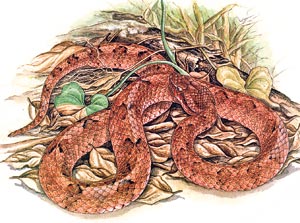 |
| Hump-nosed viper (Hypnale hypnale) |
Citing the example of a Krait-bite which mainly occurs in the North Central Province he discloses that its venom is rapidly absorbed by the body. “There are no local bite-site effects, no coagulopathy, only neuro-toxic effects which can cause respiratory muscle paralysis leading to death.”
It can happen in half-an-hour, the Sunday Times learns, and bring about death quickly.
Therefore, it is important to aid breathing and keep the victim alive until he/she can be rushed to hospital. That is why, first-aid centres have been set up in selected Medical Officer of Health (MOH) areas with the community being trained to use the “ambu bag and mask” ventilation.
In hospital, the doctors, will monitor the victim after the initial management, checking the circulatory status by keeping tabs on the blood pressure and pulse and give saline if necessary. They will check the blood-clotting time and give the anti-venom serum, while monitoring the side-effects and having adrenaline with them in case the victim develops allergies, he said.
As the serum is infused, the doctors will check within 15 minutes for a reaction and then handle that reaction, Dr. Sellahewa added.
What to do when bitten
If bitten by a snake, what should be done? The victim should be taken to the closest hospital immediately.
First aid at the spot should be to wash the bite area with soap and water or wipe with a clean cloth. The victim should not be allowed to walk or do anything vigorous as movement quickens the spread of the venom through blood circulation.
Do’s
- Reassure the patient and immobilize him and also the area where he was bitten by the snake.
- Wash the snake-bite site gently with soap and water.
- Remove rings, bangles, anklets, cords or tight clothing which could cause constriction if swelling occurs.
- Give paracetamol for pain relief.
- Take the patient to hospital as quickly as possible
Don'ts
- Don't cut open or suck out the area of the bite.
- Don't tie above or below the area of the bite or apply any kind of tourniquets.
- Don't apply chemicals such as Condy's crystals (Potassium permanganate), on the bite as they could cause tissue damage.
- Don't make the victim inhale oil or nasna.
- Don't give any alcohol, thambili, kurumba or fruit juices for the patient to drink.
- Don't give any aspirin or aspirin containing drug.
| Deadliest of them all |
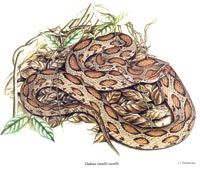 |
| Russell's viper (Daboia russelii russelii) |
Russell's viper (Daboia russelii russelii) – Slithering around mainly at night, this terrestrial snake is also sometimes spotted during the day. Its home is in the grasslands, scrub jungle, plantations, paddy fields and also chenas.
Arboreal tendencies have also been observed. Its bite does not have much local effect except swelling but systemic envenoming may cause coagulopathy and also acute renal failure. (Sinhala - Thith polanga, Dhara polonga; Tamil - Kanardi viriyan)
|
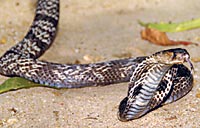 |
| Cobra (Naja naja) found in Hokandara. Pic by Sanka Vidanagama |
Cobra (Naja naja) – It is a terrestrial snake active during the day but sometimes also at night which is found close to human habitation and agricultural fields.
The local effects at bite-site are devastating with swelling, necrosis (premature death of cells and living tissue), gangrene followed by systemic envenoming resulting in neuro-toxic effect, difficulty in breathing and swallowing and ptosis. (Sinhala - Nagaya, Naya; Tamil - Naga pambu, Nalla pambu)
|
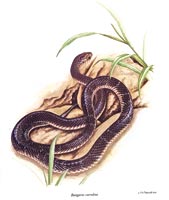 |
| Common krait
(Bungarus caeruleus) |
Common krait (Bungarus caeruleus) and Ceylon krait (Bungarus ceylonicus) – They are nocturnal, terrestrial snakes which hide in termite mounds, rodent holes, underneath and among stones or coconut husks or leaves during the day.
They cause only neuro-toxic effects but no local effects. There will be no coagulopathy but respiratory muscle paralysis can happen quickly. (Common krait in Sinhala - Thel karawala, Maga maruwa; Tamil - Yennai panayan, Yennai viriyan, Yettadi viriyan. Ceylon krait in Sinhala - Dunu karawala, Polon karawala; Tamil -Yennai panayan, Yennai viriyan, Yettadi viriyan)
|
Saw-scaled viper (Echis carinatus) – Basking in the hot sun, or resting under stones or on low vegetation, among leaf litter or in burrows, this snake is found mainly in the arid coastal areas.
Sinhala - Veli polanga; Tamil - Surattai pambu, Pal surattai)
|
Hump-nosed viper (Hypnale hypnale) – This nocturnal, terrestrial snake, lives in degraded forests and grasslands and is seen in cultivated lands such as plantations of rubber, tea, cocoa and coconut. There is pain and swelling at the bite site and rarely non-clotting of blood and acute renal failure. (Sinhala – Polontelissa; Tamil - Kopi viriyan) |
|






